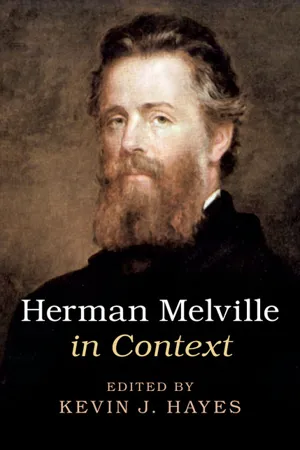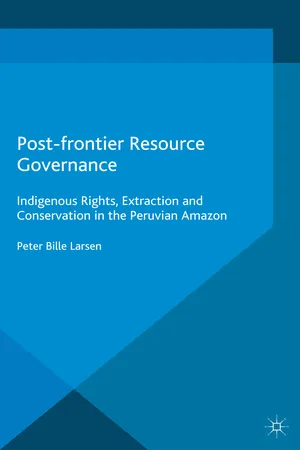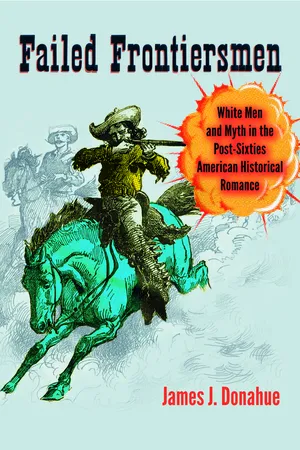Literature
Frontier Novels
Frontier novels are a genre of American literature that emerged in the late 19th and early 20th centuries. They typically depict the struggles and adventures of pioneers and settlers in the American West, often featuring themes of individualism, self-reliance, and the conquest of nature. Notable examples include "The Last of the Mohicans" by James Fenimore Cooper and "My Antonia" by Willa Cather.
Written by Perlego with AI-assistance
Related key terms
1 of 5
3 Key excerpts on "Frontier Novels"
- eBook - PDF
- Kevin J. Hayes(Author)
- 2018(Publication Date)
- Cambridge University Press(Publisher)
Four years later, with the Civil War dividing the country, Mark Twain left his job piloting steam- boats between St. Louis and New Orleans, the Fidèle’s route, and went Nathaniel Lewis 32 32 west, discovering a region burdened – comically, as Twain often had it – by its own stories. 2016: “Oh Boundless Boundary” In 1965, Edwin Fussell published Frontier: American Literature and the American West. He begins the book this way: “For an understand- ing of early American literature, the word West, with all its derivatives and variants, is the all but inevitable key.” 15 More than fifty years later, Frontier endures as an academic triumph, and when it comes to study- ing American Renaissance writers and the West, Fussell’s book remains the standard. And yet, unsurprisingly, the terms in his book’s title have undergone dramatic reconsideration in the decades since its publication. Fussell’s model of American literature reflects a mid-twentieth century idea of both “American” and “literature;” although he acknowledges writers such as Caroline Kirkland and Margaret Fuller (though not, for example, John Rollin Ridge or George Copway), his chapters are devoted to the established canon, from Cooper to Whitman. More to the point, Fussell’s notion of the American West is centered on the legacy of Frederick Jackson Turner’s Frontier Thesis, a metanarrative proposing that the nation’s his- tory is best understood as the westward-moving clash of civilization and savagery: the frontier. By the late 1990s, historians had convincingly chal- lenged that discourse, and “frontier,” with its Euro-centric orientation, transitioned to “conquest” – changing the very meaning of the region’s history and identity. Others have subsequently offered further variations on the concept of the “frontier” – as a contact zone, a diverse social space, a postmodern trickster zone – all implying the tensions around transcultura- tion and cultural marginalization. - eBook - ePub
Post-frontier Resource Governance
Indigenous Rights, Extraction and Conservation in the Peruvian Amazon
- P. Larsen(Author)
- 2016(Publication Date)
- Palgrave Macmillan(Publisher)
3 Frontier Narratives Introductionthe frontiers of civilization seldom present an attractive face, even to the unprejudiced eye. All over the planet a very real frontier conflict is being played out in these barely civilized places … the frontlines are invariably a desolate sight. Settled amid the anarchy of everything provisional and, in many cases, beyond the reach of national law … their mongrel nature is perhaps more distinct in Amazonia than anywhere else … thousands of identical little towns mushroom endlessly, each day putting out new tentacles, each day increasingly ramshackle and still without the power to swallow up the great hybrid to elicit sympathy, these towns of corrugated iron convey a degenerate image of all the worlds that they bring into confrontation. It is in one of these gloomy observation posts that ethnographic research usually begins.(Descola 1986: 1)In the above quote, one can almost hear anthropologist Philippe Descola sigh impatiently in Puyo, Ecuador, “a world”, he added, “without any real past”, before departing for his well-known study of the Jivaros. Ideas of frontier “boom” societies as half-cooked, deficient, temporary and unappealing are common in the anthropological trope to counter centuries of frontier optimism. While such counter-narratives challenge dominant tropes, they do little justice to the specific historical dynamics and narratives underscoring frontier expansion. As Tsing herself asks, “How does nature at the frontier become a set of resources? How are landscapes made empty and wild so that anyone can come to use and claim them?” (Tsing 2005: 30). This chapter suggests careful attention to the cultural production involved in creating frontiers and legitimating particular forms of frontier agency and intervention. This is particularly relevant in the Amazon, where resource abundance is frequently listed as an obvious or naturalized property despite decades of critique. Careful attention is, in other words, needed to address the specific processes reconfiguring certain places in terms of both resource abundancy and frontier permeability. Frontier creation is not simply the result of labour, capital and resources adding up in economic terms, but relies on narrative configurations of people and places that permit, attract and incite. Frontier narratives “open” up areas, whereas post-frontier narratives nominally close them. Such frontier narratives, particularly when presented in a state expansion context, involve linear projections of social change, the mobilization of certain forms of knowledge and the protagonism of external agency. This chapter offers an alternative to the common anthropological critique of frontiers as spaces of social, cultural and environmental disorder. Building on historical and ethnographic material spanning the 18th to the 20th century, the chapter zooms in on different moments in the history of Oxapampa Province in the Peruvian Amazon to explore the nature and significance of frontier narratives. Particular focus is on the intertwined roles of scientific description, entrepreneurialism and state expansion in carving out distinct frontier places and forms of action. In contrast with narratives emphasizing frontiers as spaces of disorder and the absence of regulation, the chapter underlines the significance of ordering devices in both environmental and social terms. The chapter also serves as a historical introduction for the book as a whole. - eBook - ePub
Failed Frontiersmen
White Men and Myth in the Post-Sixties American Historical Romance
- James J. Donahue(Author)
- 2015(Publication Date)
- University of Virginia Press(Publisher)
81 Although there are similarities in both subject matter and methodology, the following study does not take as its subject matter a specific place (the West), but rather a construct (the frontier), for the frontier was not one fixed location, but rather a moving zone, largely heading west (but also south) throughout the development of American history. Any study of the mythology of the American frontier must be “critically deterritorialized” because, even if the frontier is popularly thought of as “the West,” the frontier—and, as such “the West”—did not exist in a stable, fixed position. For this reason, we can focus on seventeenth-century Maryland as a frontier, though clearly Maryland would not be a subject for the New West historians. Specifically, it is the frontier (regardless of its actual location) as it has been reimagined by contemporary writers with which I am concerned.It is because “the frontier” is not coterminous with “the West” that the following chapters focus on a wide array of geographical locations, from Maryland to the Dakotas to the Mexican-American border. The frontier is not here conceived as a stable location but rather, following Mary Louise Pratt, a “contact zone” where “disparate cultures meet, clash, and grapple with each other, often in highly asymmetrical relations of domination and subordination.”82 The frontier, as I use the term in this book, is an area of conflict designated by the meeting (often violent) of two cultures. The frontier mythology, then, is the narrative developed by one of those cultures as a means of subordinating the other.In chapter 1, we will see how E. L. Doctorow and John Barth critique the means by which this narrative is developed, in their challenging of the means of written transmission; both authors invent documentary evidence that creates the circumstances for and hints at the dual failure of the frontier romance mythology described above. Chapter 2 investigates Thomas Pynchon’s more explicit challenge to the racism of the frontier mythology (as well as his implicit challenge of that mythology’s underlying sexism). In chapter 3, we will explore the Loop Garoo Kid, a figure of frontier authority whose very presence poses both a challenge and a solution to the dual failure of the mythology explored in the first three chapters. In chapter 4, we will see that the frontier need not necessarily be a zone of violent conflict. Following Louis Owens’s concept of the frontier zone as a zone of play, Gerald Vizenor explores a zone of productive as opposed to destructive contact. Finally, building off of such a definition of the frontier, chapter 5 looks at Cormac McCarthy’s Border Trilogy and Blood Meridian, and argues that the dual failure of the frontier mythology is one from which our nation likely cannot recover. Certainly, as McCarthy demonstrates, the Mexican-American border was (and still is) a zone of violent conflict. The frontier, as these chapters demonstrate, is less a physical description than an ideological construct. Or, as David E. Johnson and Scott Michaelson write of the growing interest in border theory in their introduction to Border Theory: The Limits of Cultural Politics: “Borders everywhere, but a world where no geographer’s or cartographer’s science is up to the task of mapping.”83
Index pages curate the most relevant extracts from our library of academic textbooks. They’ve been created using an in-house natural language model (NLM), each adding context and meaning to key research topics.


